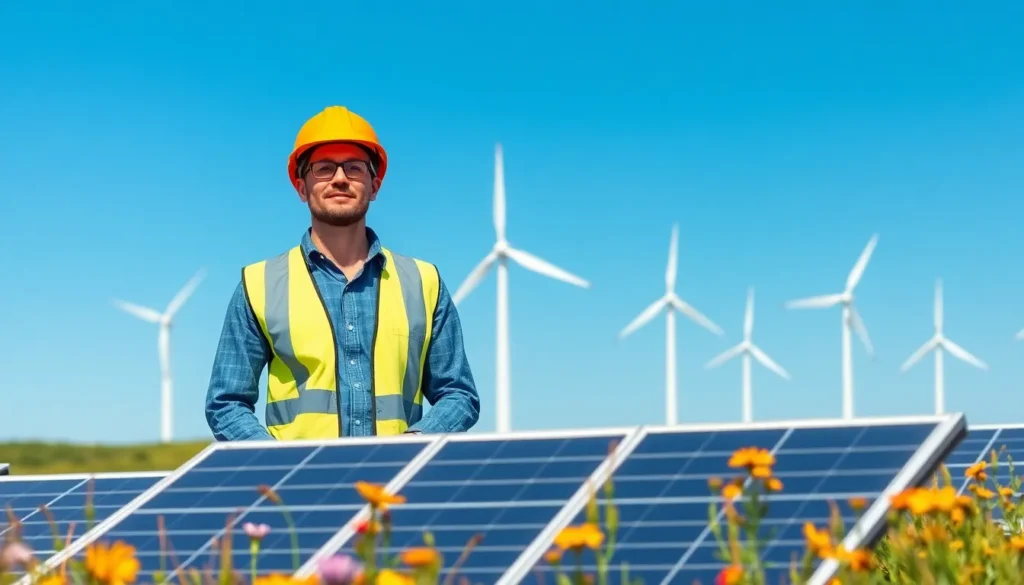In a world where fossil fuels are starting to feel like that old pair of jeans you just can’t let go of, renewable energy tech is the fresh wardrobe upgrade everyone’s talking about. Imagine harnessing the sun’s rays or the wind’s whispers to power everything from your morning coffee to your evening binge-watch sessions. It’s not just a dream; it’s happening right now, and it’s cooler than a polar bear in sunglasses.
As technology evolves at lightning speed, renewable energy solutions are transforming the way we think about power. From solar panels that look like art installations to wind turbines that could double as modern sculptures, this isn’t just about saving the planet—it’s about making energy sexy again. Buckle up as we dive into the electrifying world of renewable energy tech, where innovation meets sustainability in a way that’ll make you want to join the green revolution.
Table of Contents
ToggleOverview of Renewable Energy Tech
Renewable energy technologies encompass a range of solutions designed to harness energy from natural processes. These technologies include solar panels, wind turbines, hydropower systems, biomass energy, and geothermal systems. Each of these forms utilizes resources that regenerate naturally, significantly reducing dependency on fossil fuels.
Solar energy technology captures sunlight via photovoltaic cells to convert it into electricity. Photovoltaic systems exist in various scales, from small residential installations to large solar farms. Wind energy technology converts kinetic energy from wind into electric power using turbines. Wind farms operate both onshore and offshore, optimizing locations for maximum efficiency.
Hydropower generates energy by converting the flow of water into electricity, typically using dams or run-of-the-river systems. This approach has historically contributed a substantial portion of the global renewable energy supply. Biomass energy utilizes organic materials such as plants and waste products to produce electricity, heat, or biofuels, highlighting the versatility of renewable resources.
Geothermal technology leverages heat from the Earth’s interior for electricity generation or direct use applications. Several regions utilize geothermal plants effectively, offering reliable and sustainable energy. Investing in these renewable energy technologies enhances energy diversification and improves economic stability.
Innovative advancements continually emerge, enhancing efficiency and storage solutions in renewable energy systems. Batteries and other energy storage technologies maximize renewable energy utilization, addressing intermittency issues present in solar and wind energy. The integration of smart grids facilitates better management and distribution of renewable energy, ensuring balance and reliability.
Types of Renewable Energy Technologies

Renewable energy technologies encompass various innovative approaches to harness energy from nature. Each technology plays a crucial role in reducing fossil fuel dependence and promoting sustainability.
Solar Power Innovations
Solar power technology captures sunlight through photovoltaic cells, converting it into electricity. Recent innovations include solar panels with enhanced efficiency, capable of generating more energy from less surface area. Thin-film solar cells represent another advancement, offering flexibility and lower production costs. Building-integrated photovoltaics integrate seamlessly into structures, combining aesthetics with functionality. In addition, energy storage solutions like advanced lithium-ion batteries enable better utilization of solar energy, especially during non-sunny periods.
Wind Energy Developments
Wind energy technologies convert kinetic energy from wind into electrical power. Recent developments in turbine design focus on larger blades and taller towers, allowing for increased energy capture from wind flows. Floating wind farms expand the operational range further offshore, accessing stronger and more consistent winds. Additionally, predictive analytics enhance the efficiency of wind energy through optimized turbine operation. These advancements significantly improve overall energy output, making wind a more reliable renewable energy source.
Hydropower Advancements
Hydropower systems generate electricity by harnessing flowing water. Innovative techniques like run-of-the-river systems minimize environmental impacts while providing energy generation. Pumped-storage hydropower facilities enable energy storage and release, stabilizing energy supply during peak demand. Furthermore, modular hydropower units offer scalability, accommodating various water flow conditions. These advancements enhance the efficiency and sustainability of hydropower as a renewable energy solution.
Biomass and Biofuel Innovations
Biomass energy derives from organic materials, offering a versatile renewable energy source. New technologies focus on converting waste materials into biofuels, reducing landfill impacts while generating energy. Anaerobic digestion processes create biogas from organic matter, providing a renewable energy alternative. Additionally, advancements in enzymatic hydrolysis improve the efficiency of converting plant biomass into biofuels. These innovations present promising pathways for sustainable energy production from biomass resources.
Benefits of Renewable Energy Tech
Renewable energy technologies offer numerous advantages that contribute to a sustainable future. These benefits encompass environmental improvements and economic opportunities.
Environmental Impact
Reducing greenhouse gas emissions represents a primary environmental benefit of renewable energy tech. Harnessing solar and wind energy significantly lowers the carbon footprint compared to fossil fuels. Cleaner air results from diminished pollutants that lead to respiratory issues and other health problems. Additionally, renewable technologies promote biodiversity by minimizing habitat destruction associated with fossil fuel extraction. Protection of water resources emerges from reduced contamination linked to conventional energy sources, ensuring a healthier ecosystem. Overall, these technologies support climate change mitigation efforts globally.
Economic Advantages
Cost savings arise from the decreasing expenses associated with renewable energy technologies. The price of solar panels and wind turbines has dropped by nearly 80% since 2010, making them more accessible. Job creation plays a significant role as the renewable sector generates millions of jobs in manufacturing, installation, and maintenance. Energy independence benefits countries that invest in renewables, reducing reliance on imported fossil fuels. Furthermore, stable energy prices emerge from renewable sources, insulating economies from volatile fossil fuel markets. Overall, renewable energy technologies create a more resilient and robust economic framework.
Challenges Facing Renewable Energy Tech
Renewable energy technologies face several challenges that hinder their widespread implementation. Both technological barriers and policy related issues require attention to enhance their effectiveness.
Technological Barriers
Technological barriers significantly impact the growth of renewable energy. High initial costs for advanced technologies can deter investment. Moreover, energy storage solutions may not keep pace with energy generation, leading to reliability issues. Variability in energy output from sources like solar and wind presents additional challenges. Almost 80% of wind and solar energy generation happens during off-peak demand times, causing imbalances. Maintenance of equipment and integration with existing grids also entails significant investment. Additionally, developing efficient recycling processes for renewable energy technologies proves crucial as usage increases.
Policy and Regulatory Issues
Policy and regulatory issues complicate the deployment of renewable energy solutions. Inconsistent policies across states and countries create uncertainty for investors. Some regions lack incentives for renewable energy adoption, limiting market growth. Regulatory frameworks often fail to accommodate new technologies, creating barriers to entry. Environmental impact assessments can delay project initiation, while interconnection rules vary widely and add complexity. Collaboration among stakeholders such as governments, utilities, and private enterprises becomes critical for streamlining regulations. Continuous advocacy for supportive policies promotes an environment more conducive to renewable energy innovation.
Future Trends in Renewable Energy Tech
The future of renewable energy tech highlights numerous advancements transforming the landscape. Various emerging technologies play a crucial role in boosting energy efficiency and sustainability.
Emerging Technologies
Next-generation solar panels utilize perovskite materials to enhance energy capture. Innovations in wind energy see the creation of vertical axis wind turbines, which are more efficient in urban environments. Moreover, floating solar farms maximize space on water bodies while minimizing land use. Energy generation from algae showcases a promising biomaterial approach for sustainable biofuels. Smart home systems integrate renewable sources, optimizing energy usage and reducing waste. Additionally, wave energy converters harness ocean movements, presenting an untapped resource for energy generation. These technologies pave the way for a more resilient and sustainable energy future.
Integration with Smart Grids
Smart grids facilitate the efficient distribution of renewable energy. Intelligent systems enhance real-time data analysis, allowing for better energy demand response. Advanced metering infrastructure improves consumer awareness and control over energy consumption. Digital twins simulate energy networks, helping operators optimize performance and maintenance. Demand response programs incentivize users to shift usage during peak times, stabilizing supply. Integration of decentralized energy sources promotes energy independence and resilience. As smart grids evolve, they become critical to managing the dynamic nature of renewable energy.
The future of renewable energy technology stands as a beacon of hope for sustainable living. With continuous innovations and a commitment to overcoming challenges, the transition from fossil fuels is not just a possibility but a reality. As society embraces solar, wind, and other renewable sources, the benefits extend beyond environmental improvements to economic resilience and energy independence.
Collaboration among stakeholders and supportive policies will play a crucial role in advancing these technologies. By harnessing the power of nature, there’s potential not only to transform energy consumption but also to foster a healthier planet for future generations. The journey toward a renewable energy future is underway, and it promises to be both exciting and impactful.





